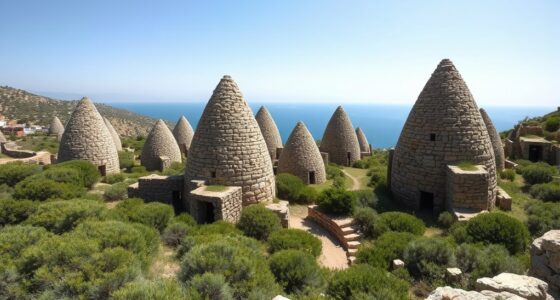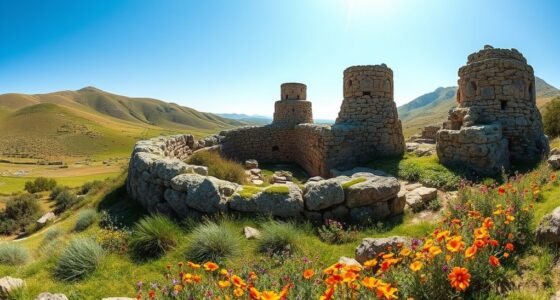The history of Sardinian independence movements spans centuries of resisting external control and preserving unique cultural identity. From early Phoenician colonies and Roman influence to regional resistance against Italian unification, Sardinia’s people have continually fought for autonomy. In the 20th century, nationalist groups like PSd’Az emerged, emphasizing language and traditions. Despite repression and political fragmentation, the drive for independence persists today. Exploring this history reveals a resilient movement rooted in culture and sovereignty that’s worth uncovering further.
Key Takeaways
- Sardinia has a long history of resistance, preserving its language, culture, and independence from Phoenician, Carthaginian, Roman, and later Italian control.
- The Sardinian Action Party (PSd’Az) emerged in the early 20th century advocating for regional autonomy and cultural preservation.
- Cultural revival movements in the 1960s-70s fostered pride and activism, blending identity with anti-colonial ideas and political mobilization.
- Political fragmentation and internal divisions have limited the influence of nationalist parties, despite consistent regional support for autonomy and independence.
- Contemporary Sardinian movements focus on self-determination, legal battles over resources, and environmental activism, maintaining strong regional identity.
Early Colonial Influences and Cultural Foundations
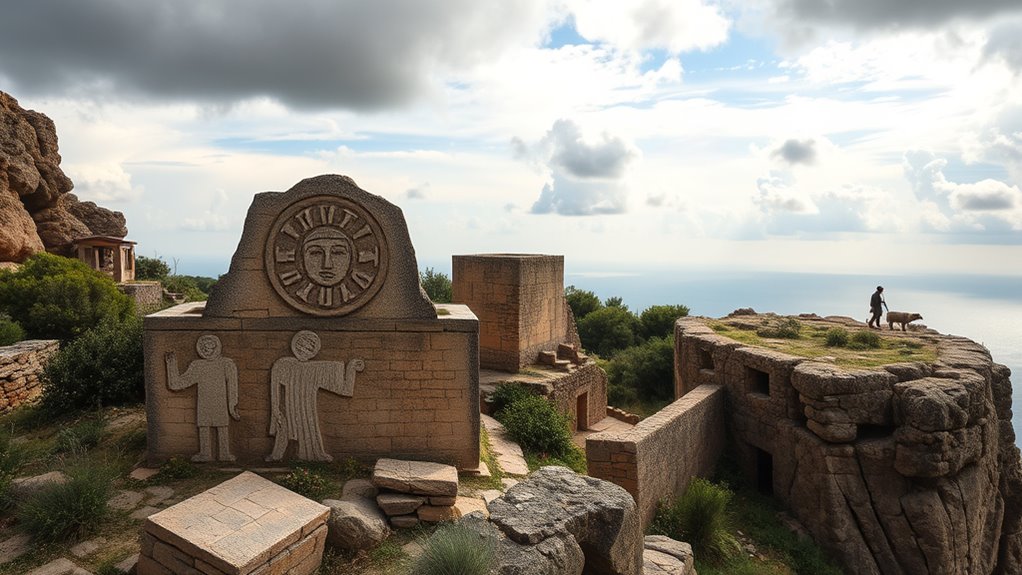
The early colonial influences on Sardinia laid the groundwork for its unique cultural identity. From the 9th century BC, Phoenicians established trading colonies along the coast, making the island a crucial strategic outpost. Later, Carthaginians took control, valuing Sardinia’s resources and adding new cultural layers. These civilizations brought trade networks, maritime skills, and influences that shaped local traditions. Despite external control, Sardinian natives resisted and preserved their distinct customs. During the First Punic War, Carthaginian mercenaries revolted, and Rome eventually conquered the island in 240 BC. Roman rule introduced new legal and infrastructural systems, blending with local traditions. These systems facilitated cultural integration and laid a foundation of diverse cultural influences that continue to define Sardinia’s identity today. Roman infrastructure and laws also facilitated the integration of Sardinia into the Roman Empire, further embedding it into Mediterranean trade routes.
Sardinia’s Role in 19th Century Italian Unification

During the 19th century, Sardinia emerged as the driving force behind Italy’s unification, with King Victor Emmanuel II at its helm. You see, Sardinia’s strong monarchy and organized military set it apart from other Italian states. Prime Minister Count Cavour used diplomatic strategies, securing alliances with France and participating in the Crimean War to boost Sardinia’s standing. The Austro-Sardinian War in 1859, supported by France, aimed to weaken Austria’s hold on northern Italy. Victories at Magenta and Solferino led to Austria ceding Lombardy, which Sardinia annexed. This opened the door for further expansion, including the annexation of the Two Sicilies and parts of the Papal States, often with nationalist volunteers like Garibaldi supporting Sardinian leadership. Cavour’s diplomatic efforts helped to unify Italy under Sardinian leadership. By 1861, Italy was unified under Sardinian rule.
The Rise of Sardinian Nationalist Sentiments in the Early 20th Century
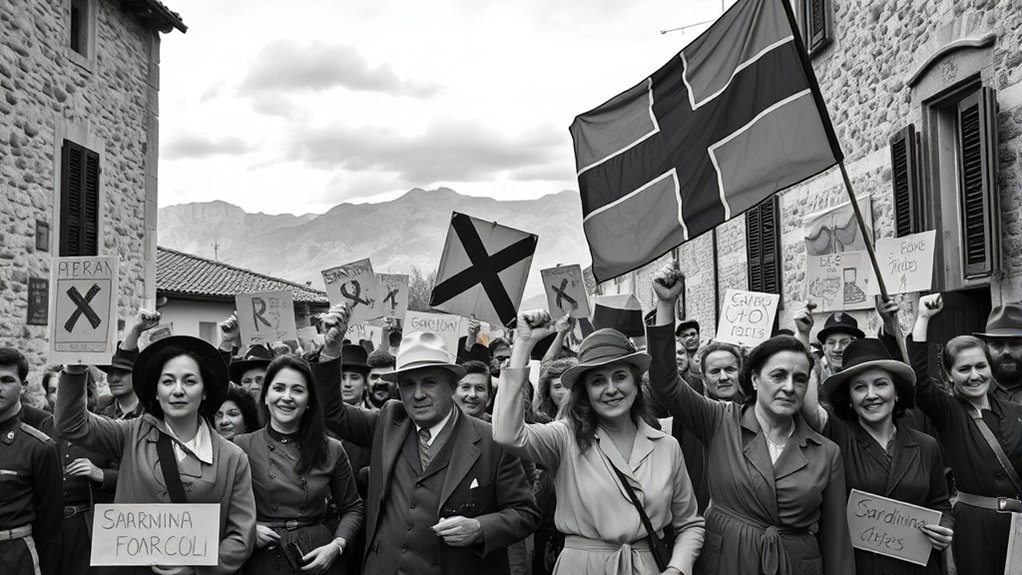
In the early 20th century, Sardinian cultural identity gained momentum as local language, traditions, and history became rallying points for nationalists. You’ll see how political activism grew with the founding of parties like the Sardinian Action Party, which mobilized support for regional self-determination. This period marked the beginning of organized efforts to assert Sardinia’s distinct identity within Italy. The Sardinian Action Party (PSdAz) was founded during this time, advocating for regional autonomy and cultural recognition.
Emergence of Cultural Identity
At the turn of the 20th century, Sardinian intellectuals and landowners began to shape a distinct cultural identity rooted in language and traditions. They emphasized preserving the Sardinian language and customs as key markers of their uniqueness, inspired by anti-centralist and republican ideas that celebrated Sardinia’s history. Drawing lessons from European independence movements, especially Ireland’s 1921 independence, they aimed to resist Italian bureaucratic control and promote regional self-determination. The cultural revival became a foundation for nationalist sentiment, fostering pride in Sardinian identity. This movement laid the groundwork for political activism, with cultural symbols and traditions fueling a shared sense of belonging and resistance against assimilation, setting the stage for the emergence of organized Sardinian nationalist parties and movements. Additionally, the movement drew inspiration from cultural heritage preservation efforts seen in other indigenous groups, further solidifying their commitment to safeguarding Sardinian traditions.
Political Activism and Parties
The early 20th century marked a pivotal shift as Sardinian nationalism moved from intellectual debate to active political engagement, inspired by Ireland’s 1921 independence movement. You see this rise reflected in the formation of the Sardinian Action Party (PSd’Az), which, by 1921, secured 36% of the regional vote. The party promoted republicanism, federalism, and peasant socialism, with only a minority supporting outright independence. This era marked Sardinian nationalism becoming a mass movement, challenging Italy’s centralized policies and traditional narratives.
- The PSd’Az’s breakthrough in elections.
- Its advocacy for federalism and socialism.
- The movement’s shift from intellectuals to voters.
- The limited support for outright independence.
Suppression and Resilience During Fascist Rule
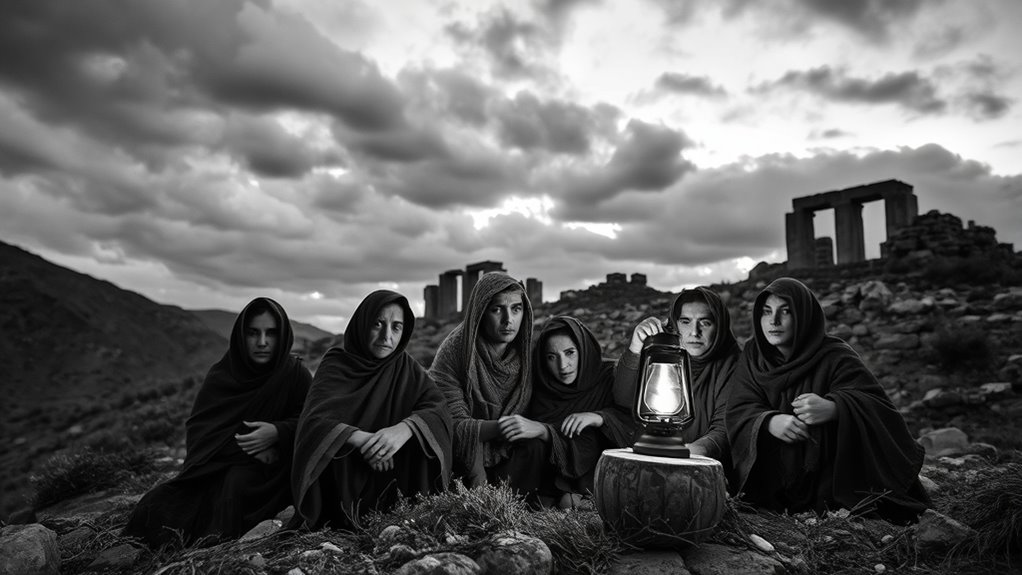
During Fascist rule, you see how Sardinian identity faced harsh suppression, with activists and organizations banned or persecuted. Despite this, underground movements kept resisting, reemerging after 1943 to continue advocating for autonomy. Their resilience highlights how Sardinians refused to surrender their sense of nationhood under oppressive regimes.
Suppression of Sardinian Identity
Fascist Italy actively suppressed Sardinian identity by banning political groups like the Sardinian Action Party and marginalizing the Sardinian language and cultural expressions. You’d find Sardinian nationalism forced underground, with public activism silenced. The regime excluded Sardinian from public life, pushing a unified Italian identity. Here’s how they did it:
- Banned Sardinian political parties and marginalized the language.
- Promoted Roman imperial heritage, dismissing local identities.
- Limited cultural expressions, especially in rural areas.
- Favored urban elites, offering some infrastructure funding to placate them.
- Targeted Sardinian cultural festivals and traditions, attempting to erase regional customs and history. Additionally, the regime aimed to suppress regional symbols and practices, further diminishing Sardinian cultural identity.
Despite this repression, Sardinian nationalism persisted secretly. Leaders like Emilio Lussu fought abroad, and post-WWII, regional pride surged again, with surveys showing strong support for independence by 2012 and 2017.
Resistance and Underground Movements
Despite relentless repression, Sardinian resistance movements persisted underground, showcasing remarkable resilience under Mussolini’s regime. After the banning of groups like PSd’Az in 1926, members operated covertly to evade fascist repression. Some joined broader European anti-fascist fronts, like Emilio Lussu and others who fought in the Spanish Civil War, symbolizing Sardinia’s contribution to the anti-fascist struggle. Mussolini’s secret police used surveillance and repression to disrupt these networks, leading to imprisonment and exile for many activists. Rural populations largely resisted or remained indifferent to fascist control, while urban bourgeois groups sometimes supported it. Despite heavy suppression, a core of underground dissent endured, keeping Sardinian nationalist ideals alive and connecting local resistance to wider European anti-fascist efforts. These clandestine activities demonstrated the determination of Sardinian patriots to preserve their cultural identity and political aspirations despite oppressive circumstances.
Post-World War II Political Fragmentation and Revival

After World War II, the Sardinian independence movement faced significant fragmentation that hampered its political influence. You’d see splits weaken parties like Psd’Az, which lost members and split into factions. The divide between federalists seeking more autonomy and independence advocates, especially radicals like IRS, deepened divisions.
- Small parties, such as SN and IRS, ran separately in elections, causing vote splitting.
- Despite a combined vote of around 26%, they secured only eight regional council seats.
- Internal disagreements and tactical errors limited electoral success and influence.
- Italian national politics absorbed regionalist rhetoric, diluting Sardinian demands.
- The regional independence movement struggled to present a united front, further decreasing its effectiveness.
- The rise of regionalist rhetoric within celebrity lifestyle insights has also contributed to shifting political priorities and perceptions.
This fragmentation made it hard to build unified coalitions, reducing the movement’s power to shape policies or negotiate autonomy.
Cultural Identity and Language as Pillars of Movement
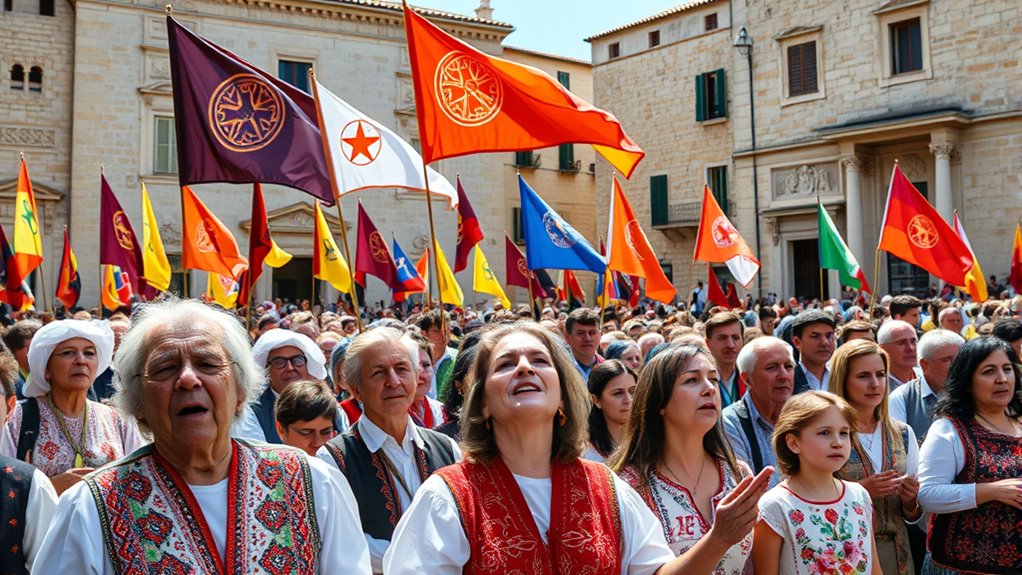
Cultural identity and language serve as the backbone of Sardinian independence movements, embodying the island’s distinct history and social fabric. Sardinians have a long history of resistance, from the revolt in 1794 to five centuries of independence, shaping a strong sense of uniqueness. The Sardinian language, Sardismu, is central to asserting cultural and political distinctiveness. Activists have fought since the 1960s to preserve it through education and media, framing it as a symbol of resistance. Socio-cultural groups in the 1960s and 1970s, like Su Populu Sardo, mobilized around identity, blending anti-colonial ideas with cultural preservation. Celebrations like Sa Die De Sa Sardigna reinforce collective memory, while language revival efforts emphasize self-determination and resistance to external domination. Obsidian trade and Nuragic civilization are also key elements that contribute to Sardinia’s unique identity and its historical narrative of resilience. Additionally, cultural resilience reflects the enduring spirit of the Sardinian people in maintaining their traditions and autonomy throughout centuries of external pressures.
Contemporary Autonomy and Independence Advocacy

Contemporary Sardinian autonomy and independence advocacy are shaped by a dynamic political landscape that spans the spectrum from left-wing nationalism to center and right-wing parties. You’ll find that Sardinian nationalism, or Sardism, pushes for self-determination, from greater autonomy to full independence. Here’s what’s happening now:
- Several parties, including the Sardinian Action Party, hold around 26% of the vote, showing notable support but no dominant force.
- Fragmentation among nationalist groups makes coalition-building difficult, limiting unified influence.
- Sardinia’s special autonomous status grants it legislative powers, but secessionist sentiments persist, especially over economic control. Building political cohesion
- Environmental and energy activism now drives the movement, with protests demanding control over resources and sustainable policies.
- The island’s push for self-determination is further reinforced by recent legal battles over regional jurisdiction and resource management highlighting the ongoing struggle for regional sovereignty.
Frequently Asked Questions
How Did Spanish Rule Influence Sardinian Cultural Identity?
Spanish rule shaped your Sardinian cultural identity by embedding Spanish customs, language, and traditions into daily life. You can still see Catalan influence in places like Alghero, where Catalan speakers persist. Spanish governance also fostered a sense of resistance and pride, fueling your desire to preserve local traditions. This history created a unique blend of cultures that defines Sardinia’s identity today, making you aware of your distinct roots and resilience.
What Role Did Sardinian Leaders Play in Italian Unification?
When it comes to Italian unification, you see Sardinian leaders really took the bull by the horns. Victor Emmanuel II led militarily, while Cavour used diplomacy to gain allies and territory. They worked together, turning Sardinia into the driving force behind unification. Their strategic alliances and pragmatic politics helped bring various Italian states together, making Sardinia the backbone of Italy’s new unified nation.
When Did Sardinian Nationalism First Gain Political Organization?
You’re asking when Sardinian nationalism first gained political organization. It happened in 1921 with the founding of the Sardinian Action Party (Partito Sardo d’Azione, PSd’Az). This party marked the beginning of structured Sardist politics, inspired by Irish independence and advocating for regional self-rule. You can see it quickly gained support, winning 36% of votes in that year’s regional election, signaling a strong desire for Sardinian self-determination.
How Did Fascist Policies Impact Sardinian Cultural Independence?
Fascist policies choked Sardinian cultural independence like a tightening grip on a delicate flower. You’d see Sardinian language banned and traditions erased, making Sardinia’s identity fade into the shadows of Italianization. These policies stigmatized your culture, built walls of prejudice, and suppressed your voice. The result? A fractured connection to your roots, leaving Sardinians feeling inferior and their cultural soul stifled under the weight of oppressive assimilation.
What Are the Main Contemporary Demands of Sardinian Independence Advocates?
You see that Sardinian independence advocates mainly want greater self-determination, including full political autonomy or independence. They push for a regional statute with broader powers over local matters like law, education, and resources. You also notice their focus on safeguarding Sardinian language and culture, resisting assimilation, and controlling environmental and economic policies to ensure sustainable development. They emphasize judicial independence and increased local participation in governance, aiming for a stronger, self-reliant Sardinian identity.
Conclusion
You can see that Sardinia’s fight for independence is like a resilient tree, rooted deep in rich history and culture. Despite setbacks and suppression, the island’s spirit remains unbroken, standing tall against the winds of change. As you witness their ongoing efforts, remember that their desire for autonomy isn’t just a political quest, but a vibrant heartbeat echoing through time—proof that true identity can’t be silenced, only strengthened.


